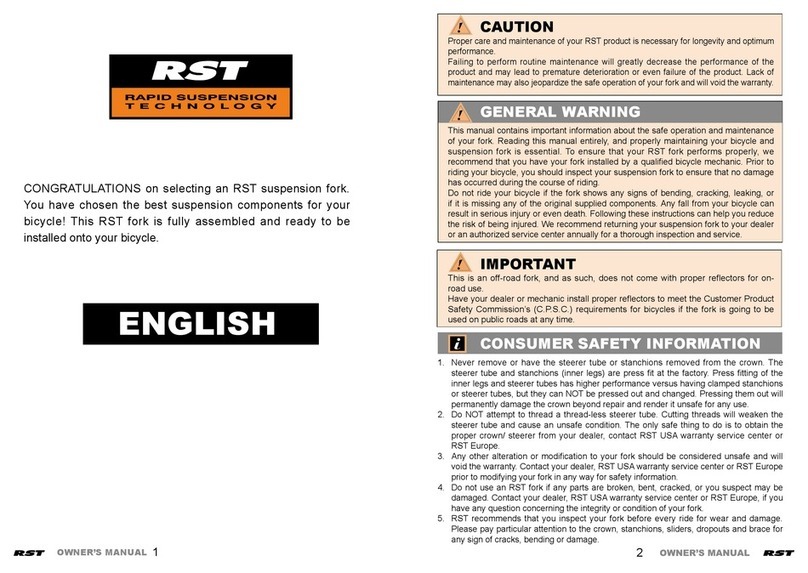
OWNER’S MANUAL 3
Any RST fork found, by the factory, to be defective in materials and/or workmanship
within two year from the date of purchase will be repaired or replaced at the option of the
manufacturer, free of charge, when received at the factory with proof of purchase, freight
prepaid. This warranty does not cover any fork that has been subject to misuse or abuse,
including but not limited to, any breakage, bending, damage cause by crashes and/or
assembly, improper maintenance, or other excessive, improper or abnormal conditions.
This warranty does not cover paint damage.
Any modications or alterations made by the user will render the warranty null and void.
This warranty is expressly in lieu of all other warranties, and any implied are limited
in duration to the same duration as the expressed warranty herein. RST shall not be
liable for any incidental or consequential damages. In the event that a product needs to
be replaced and is discontinued or not available, RST reserves the right to replace the
product with one of equal value, no credit or refund will be issued.
This product is not intended for use in stunt or acrobatics riding, ramp jumping, or similar
activities, the user assumes all risks of personal injury, product damage or failure, and any
other losses which may arise under such use.
If for any reason, warranty work is necessary, return the fork to the place of purchase, In
the USA and Canada, dealers should call RST USA warranty service center. Customers in
countries other than USA should contact their local dealer or distributor or RST Europe.
It is extremely important that your RST fork is installed correctly by a qualified bicycle
mechanic. Improperly installed forks are extremely dangerous and can result in serious
and/or fatal injuries. Ensure that the proper steerer tube has been delivered on your RST
fork. The steerer tube may need to be cut to length to t your bicycle head tube. If you
are not familiar with this procedure, or do not have proper tools to cut the steerer tube,
it is recommended that you seek a dealer with a qualied bicycle mechanic to perform
installation.
1. Remove the old fork from your bike.
2. Measure the length of steerer tube to t your bicycle head tube, make sure there is
sufcient length to install the stem (refer to the stem manufacturer’s instructions), you
can use your old fork as guide for cutting the length of steerer tube.
WARRANTY INFORMATION
INSTALLATION INSTRUCTION
The steerer tube and stanchions (inner legs) are a one-time precision press t at the
factory and can not be removed from the crown. Replacement of the entire crown/
steerer assembly must be done to change steerer tube lengths or diameters.
Attempting to remove and replace the steerer tube or stanchions will result in an
unsafe condition and should never be done.
WARNING
FORK INSTALLATION




























